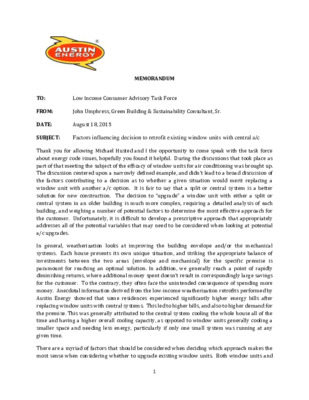Item 5b-Staff Response-Factors influencing decision to retrofit existing window units with central ac — original pdf
Backup

1 MEMORANDUM TO: Low Income Consumer Advisory Task Force FROM: John Umphress, Green Building & Sustainability Consultant, Sr. DATE: August 18, 2015 SUBJECT: Factors influencing decision to retrofit existing window units with central a/c Thank you for allowing Michael Husted and I the opportunity to come speak with the task force about energy code issues, hopefully you found it helpful. During the discussions that took place as part of that meeting the subject of the efficacy of window units for air conditioning was brought up. The discussion centered upon a narrowly defined example, and didn’t lead to a broad discussion of the factors contributing to a decision as to whether a given situation would merit replacing a window unit with another a/c option. It is fair to say that a split or central system is a better solution for new construction. The decision to “upgrade” a window unit with either a split or central system in an older building is much more complex, requiring a detailed analysis of each building, and weighing a number of potential factors to determine the most effective approach for the customer. Unfortunately, it is difficult to develop a prescriptive approach that appropriately addresses all of the potential variables that may need to be considered when looking at potential a/c upgrades. In general, weatherization looks at improving the building envelope and/or the mechanical systems. Each house presents its own unique situation, and striking the appropriate balance of investments between the two areas (envelope and mechanical) for the specific premise is paramount for reaching an optimal solution. In addition, we generally reach a point of rapidly diminishing returns, where additional money spent doesn’t result in correspondingly large savings for the customer. To the contrary, they often face the unintended consequence of spending more money. Anecdotal information derived from the low-income weatherization retrofits performed by Austin Energy showed that some residences experienced significantly higher energy bills after replacing window units with central systems. This led to higher bills, and also to higher demand for the premise. This was generally attributed to the central system cooling the whole house all of the time and having a higher overall cooling capacity, as opposed to window units generally cooling a smaller space and needing less energy, particularly if only one small system was running at any given time. There are a myriad of factors that should be considered when deciding which approach makes the most sense when considering whether to upgrade existing window units. Both window units and 2 central systems may have advantages for a given circumstance. Central units have a longer expected service life (up to 15 years vs. 5-9 years for a window unit) and higher efficiency. Another advantage of a central system over window units is that a heating system (furnace or heat pump) is integral to it. Window units tend to be less expensive up front. Multiple window units in a residence can be operated one at a time, reducing the demand on the grid and reducing costs for the residence. Conversely, in given circumstances both central and window units may have drawbacks. With window units, a separate heating system is required. Window heat pumps are expensive and often require electric system upgrades to allow their installation. They generally have a mediocre coefficient of performance in heating mode, and excessive reliance on the electric resistance heating can increase operating costs. All of that must be weighed with the number of heating days the customer is likely to experience. Ductwork to accommodate central systems can be challenging and/or expensive to install in some buildings, particularly those with limited attic space. In a potential retrofit situation, replacing existing window units with new higher efficiency window units may have a much better return on investment vs. retrofitting with a central unit. This may be true even given the shorter projected lifespan of window units. Attached are two spreadsheets showing the ROI differential from retrofitting window units with higher efficiency models vs. lower efficiency systems generated using an Energy Star calculator and typical Austin inputs for rates and cooling loads. Although the calculator doesn’t directly show the payback on a new high efficiency unit, you can extrapolate from the calculator that the payback is between 3 and 3 ½ years for simple replacement of an older, low EER (EER of 8 in this case) unit. This decision may be complicated by how the residence is heated. A house with existing gas heat may favor a different mechanical option than a house with space heaters, or a house with electric strip heaters. All of these elements must be factored into the decision matrix when looking at cooling equipment options. Things to consider when comparing a central system to window units include: Age and condition of the dwelling unit and equipment Number of rooms requiring space conditioning (especially cooling) Suitability of either equipment to a particular dwelling unit- match with design, type of heat Initial cost- equipment, installation, permitting (if applicable) Cost over time- energy, maintenance Cost of operation to the resident Demand upon the grid Customer behavior Program objectives The key takeaway is that the decision of whether it makes sense to replace window unit(s) with a central system requires analyzing a number of inputs, and is highly dependent upon the specific situation. Not taking all of these inputs into consideration can lead to unintended consequences such as a higher total energy burden for a given customer, or excessively high investments by the 3 utility for relatively small incremental gains in overall building efficiency. Prescriptive solutions are difficult to develop for requiring window unit upgrades due to the complexity and variability of each situation. Please take these points into consideration as you craft your recommendations. If you would like explore this topic in more detail, I’m more than happy to answer additional questions.